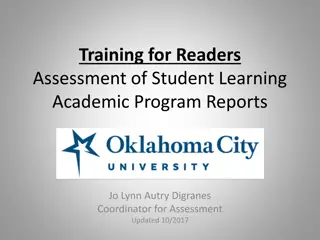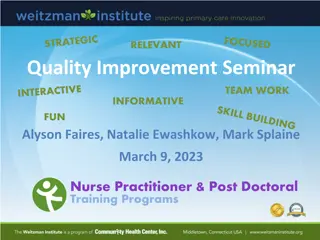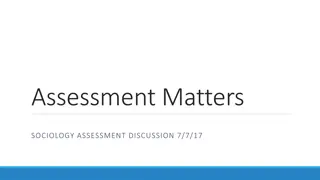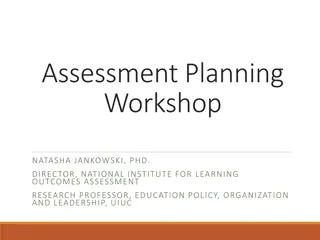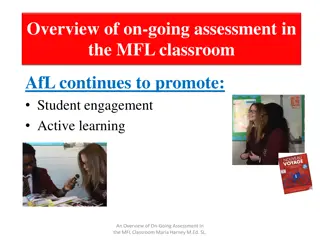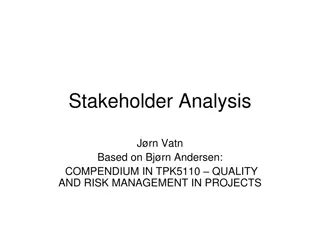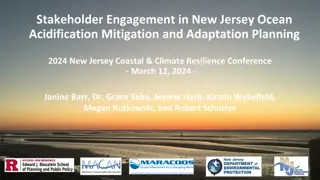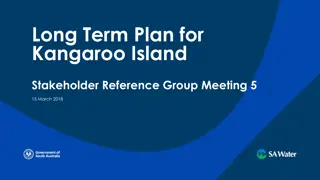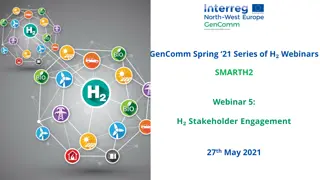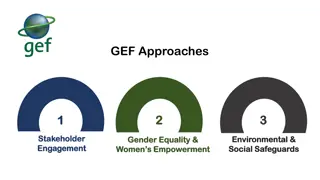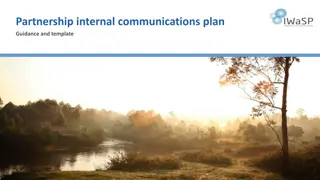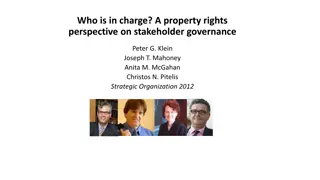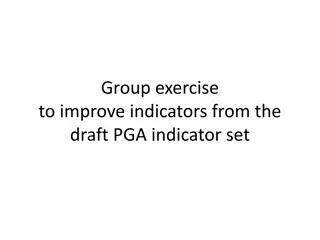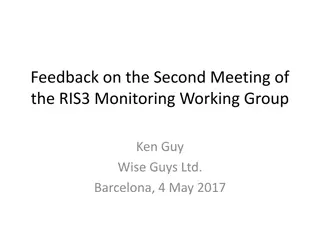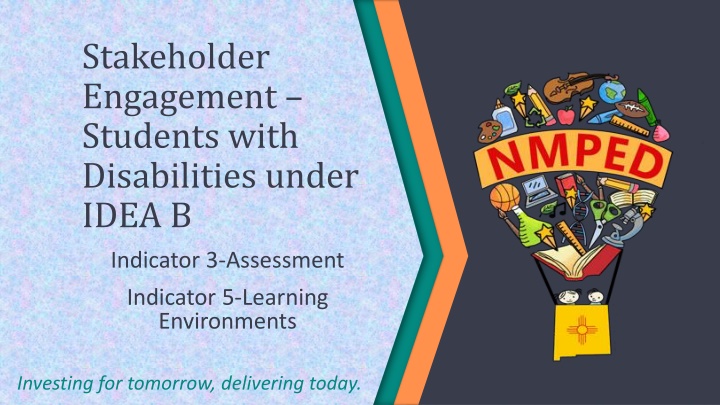
Enhancing Stakeholder Engagement for Students with Disabilities
This content focuses on stakeholder engagement for students with disabilities under IDEA, specifically addressing assessment and learning environments. It delves into meeting norms for housekeeping, involving parents/guardians in providing input, utilizing tools like Jamboard, and introducing the State Performance Plan (SPP) and Annual Performance Report (APR) in compliance with the Individuals with Disabilities Education Act (IDEA). The overview emphasizes the importance of data collection and reporting for ensuring effective implementation of educational programs for students with disabilities.
Download Presentation

Please find below an Image/Link to download the presentation.
The content on the website is provided AS IS for your information and personal use only. It may not be sold, licensed, or shared on other websites without obtaining consent from the author. If you encounter any issues during the download, it is possible that the publisher has removed the file from their server.
You are allowed to download the files provided on this website for personal or commercial use, subject to the condition that they are used lawfully. All files are the property of their respective owners.
The content on the website is provided AS IS for your information and personal use only. It may not be sold, licensed, or shared on other websites without obtaining consent from the author.
E N D
Presentation Transcript
Stakeholder Engagement Students with Disabilities under IDEA B Indicator 3-Assessment Indicator 5-Learning Environments Investing for tomorrow, delivering today.
Housekeeping Meeting Norms Everyone has valuable information to provide Raise your hand via Zoom Liz Schweiger will acknowledge those with raised hands Lower hand 2 Investing for tomorrow, delivering today.
Housekeeping Meeting Norms Parents/Guardians will have the option to provide input first Chat box available for questions Moderated by Leah Johnson Jamboard available for feedback Moderated by Matthew Kump 3 Investing for tomorrow, delivering today.
Jamboard Matthew Kump
Introduction to the State Performance Plan (SPP)/Annual Performance Report (APR)
Individuals with Disabilities Education Act Part B A student that 1.Has a disability and 2.The need for specialized instruction Disability Categories: - Intellectual Disability - Hearing Impairment - Speech or Language Impairment - Visual Impairment - Emotional Disturbance - Orthopedic Impairment - Autism - Traumatic Brain Injury - Other Heath Impairment - Specific Learning Disability - Deaf-Blindness - Multiple Disabilities Gifted Services are a New Mexico rule and gifted students are not counted in any of the data reported to the Office of Special Education Programs (OSEP) 6 Investing for tomorrow, delivering today.
Overview of the State Performance Plan (SPP)/ Annual Performance Report (APR) States receiving funds from the U.S. Department of Education, to implement the Individuals with Disabilities Education Act (IDEA) must develop a State Performance Plan (SPP) The SPP describes State efforts to meet the requirements and purposes of IDEA, Part B States must report on the performance of the SPP through the Annual Performance Report (APR) Completing the SPP and APR relies on the collection and use of a variety of data 7 Investing for tomorrow, delivering today.
IDEA B Indicators Reporting in the SPP/APR 2 Types of Indicators Compliance and Target Indicators Indicators up to FFY2019: Compliance Indicators Target Indicators Indicator 4B Suspension/Expulsion Indicator 8 Parent Involvement Indicator 1 Graduation Indicator 9 Disproportionate Representation Indicator 2 Drop out Indicator 14 Post-School Outcomes Indicator 10 Disproportionate Representation Indicator 15 Resolution Sessions Indicator 3B & 3C Assessment Participation & Outcomes Indicator 11 Child Find/60 Day Timeline Indicator 4A Suspension/Expulsion Indicator 16 Mediation Indicator 12 Part C to B Transition Indicator 5 Education Environments Indicator 13 Secondary Transition Indicator 6 Preschool Education Environments Indicator 7 Preschool Outcomes 8 Investing for tomorrow, delivering today.
IDEA B Indicators Changes in the SPP/APR Indicators for FFY2020 to FFY 2025: 9 Investing for tomorrow, delivering today.
Indicator 3B to 3A Statewide Assessment Participation Rates of Students with Disabilities
Indicator Information for Indicator 3B Reporting measurement requirements FFY 2019 Data Source: Describe the results of the calculations and compare the results to the targets. Provide the actual numbers used in the calculation. 3. Participation and performance of children with IEPs on statewide assessments: 3B. Same data as used for reporting to the Department under Title I of the ESEA, using EDFacts file specifications C185 and 188. A. Indicator 3A -- Reserved Include information regarding where to find public reports of assessment participation and performance results, as required by 34 CFR 300.160(f), i.e., a link to the Web site where these data are reported. 3C. Same data as used for reporting to the Department under Title I of the ESEA, using EDFacts file specifications C175 and 178. B. Participation rate for children with IEPs. C. Proficiency rate for children with IEPs against grade level and alternate academic achievement standards. Indicator 3B: Provide separate reading/language arts and mathematics participation rates, inclusive of all ESEA grades assessed (3-8 and high school), for children with IEPs. Account for ALL children with IEPs, in all grades assessed, including children not participating in assessments and those not enrolled for a full academic year. Only include children with disabilities who had an IEP at the time of testing. Measurement: B. Participation rate percent = [(# of children with IEPs participating in an assessment) divided by the (total # of children with IEPs enrolled during the testing window)]. Calculate separately for reading and math. The participation rate is based on all children with IEPs, including both children with IEPs enrolled for a full academic year and those not enrolled for a full academic year. (20 U.S.C. 1416 (a)(3)(A)) Indicator 3C: Proficiency calculations in this SPP/APR must result in proficiency rates for reading/language arts and mathematics assessments (combining regular and alternate) for children with IEPs, in all grades assessed (3-8 and high school), including both children with IEPs enrolled for a full academic year and those not enrolled for a full academic year. Only include children with disabilities who had an IEP at the time of testing. C. Proficiency rate percent = [(# of children with IEPs scoring at or above proficient against grade level and alternate academic achievement standards) divided by the (total # of children with IEPs who received a valid score and for whom a proficiency level was assigned)]. Calculate separately for reading and math. The proficiency rate includes both children with IEPs enrolled for a full academic year and those not enrolled for a full academic year. 11 Investing for tomorrow, delivering today.
Indicator 3B Assessment Participation FFY 2019 Data: The state filed for and received a waiver for administering a statewide assessment due to the COVID-19 pandemic. FFY 2018 Data: Reading Group Name Overall Overall FFY 2018 95.00% 99.56% Target Actual Math Group Name Overall Overall FFY 2018 95.00% 99.56% Target Actual 12 Investing for tomorrow, delivering today.
FFY20-25 Indicator 3: Assessment Changes 3A Participation rates for children with IEPs 3B Proficiency rates for children with IEPs against grade-level academic achievement standards 3C Proficiency rates for children with IEPs against alternate academic achievement standards 3D Gap in proficiency rates for children with IEPs and all students against grade-level academic achievement standards 13 Investing for tomorrow, delivering today.
FFY20-25 Indicator 3: Assessment Changes Provide data separately for each sub indicator for reading/language arts and math Calculate separately for each: 4th grade, 8th grade, and high school Data for baseline will be 2020-2021 (current school year) Provide new baselines for each sub indicator and grade (12 baselines) Provide new targets for each sub indicator and grade 14 Investing for tomorrow, delivering today.
Indicator Information for Indicator 3A Reporting measurement requirements FFY 2020-2025 3. Participation and performance of children with IEPs on statewide assessments: 3A. Same data as used for reporting to the Department under Title I of the ESEA, using EDFacts file specifications C185 and 188. Data Source: Describe the results of the calculations and compare the results to the targets. Provide the actual numbers used in the calculation. Include information regarding where to find public reports of assessment participation and performance results, as required by 34 CFR 300.160(f), i.e., a link to the Web site where these data are reported. A. Participation rate for children with IEPs. 3B. Same data as used for reporting to the Department under Title I of the ESEA, using EDFacts file specifications C175 and 178. B. Proficiency rate for children with IEPs against grade level academic achievement standards. Indicator 3A: Provide separate reading/language arts and mathematics participation rates for children with IEPs for each of the following grades: 4, 8, & high school. Account for ALL children with IEPs, in grades 4, 8, and high school, including children not participating in assessments and those not enrolled for a full academic year. Only include children with disabilities who had an IEP at the time of testing. 3C. Same data as used for reporting to the Department under Title I of the ESEA, using EDFacts file specifications C175 and 178. C. Proficiency rate for children with IEPs against alternate academic achievement standards. 3D. Same data as used for reporting to the Department under Title I of the ESEA, using EDFacts file specifications C175 and 178. A. Gap in proficiency rates for children with IEPs and all students against grade level academic achievement standards. Measurement: A. Participation rate percent = [(# of children with IEPs participating in an assessment) divided by the (total # of children with IEPs enrolled during the testing window)]. Calculate separately for reading and math. Calculate separately for grades 4, 8, and high school. The participation rate is based on all children with IEPs, including both children with IEPs enrolled for a full academic year and those not enrolled for a full academic year. B. Proficiency rate percent = [(# of children with IEPs scoring at or above proficient against grade level academic achievement standards) divided by the (total # of children with IEPs who received a valid score and for whom a proficiency level was assigned for the regular assessment)]. Calculate separatelyfor reading and math. Calculate separately for grades 4, 8, and high school. The proficiency rate includes Indicator 3B: Proficiency calculations in this SPP/APR must result in proficiency rates for children with IEPs on the regular assessment in reading/language arts and mathematics assessments (separately) in each of the following grades: 4, 8, and high school, including both children with IEPs enrolled for a full academic year and those not enrolled for a full academic year. Only include children with disabilities who had an IEP at the time of testing. (20 U.S.C. 1416 (a)(3)(A)) Indicator 3C: Proficiency calculations in this SPP/APR must result in proficiency rates for children with IEPs on the alternate assessment in reading/language arts and mathematics assessments (separately) in each of the following grades: 4, 8, and high school, including both children with IEPs enrolled for a full academic year and those not enrolled for a full academic year. Only include 15 Investing for tomorrow, delivering today.
New Indicator 3A Measurement # of children with IEPs participating in an assessment total # of children with IEPs enrolled during the testing window Calculated separately for: Reading and Math Grades 4, 8, and high school. 16 Investing for tomorrow, delivering today.
Indicator 3A (Previously 3B) Baselines Each Target Indicator requires Baselines: Starting point. Reading Baseline 2014 Year Baseline Established 97.75% Baseline Rate Math Baseline 2014 Year Baseline Established 97.82% Baseline Rate 17 Investing for tomorrow, delivering today.
Indicator 3A (Previously 3B) Targets Each Target Indicator requires Targets: The rate which the state must meet. Reading FFY 2014 2015 2016 2017 2018 Target 95.00% 95.00% 95.00% 95.00% 95.00% State Rate 97.75% 95.77% 99.44% 95.85% 99.56% Math FFY 2014 2015 2016 2017 2018 Target 95.00% 95.00% 95.00% 95.00% 95.00% Actual 97.82% 95.41% 99.21% 92.73% 99.56% 18 Investing for tomorrow, delivering today.
Indicator 3A (Previously 3B) Targets and State Rate Comparison Last 6 Years of Targets and State Rate Reading FFY 2014 2015 2016 2017 2018 Target 95.00% 95.00% 95.00% 95.00% 95.00% State Rate 97.75% 95.77% 99.44% 95.85% 99.56% Target Met Target Met Target Met Target Met Target Met Math FFY 2014 2015 2016 2017 2018 Target 95.00% 95.00% 95.00% 95.00% 95.00% Actual 97.82% 95.41% 99.21% 92.73% 99.56% Target Met Target Met Target Met Target Met Target Met 19 Investing for tomorrow, delivering today.
Indicator 3B Assessment Participation Rates 102.00% 100.00% 98.00% 96.00% 94.00% 92.00% 90.00% 88.00% 2016 2017 2018 Reading Math Target 20 Investing for tomorrow, delivering today.
Indicator 3B (3A) Reading Assessment Participation Rate of Growth (Loss) Rate of Growth/Loss Between Years Difference Between Target and State Data FFY 2014 to FFY 2015: 1.98% FFY 2014: 2.75% FFY 2015 to FFY 2016: 3.67% FFY 2015: 0.77% FFY 2016 to FFY 2017: 3.59% FFY 2016: 4.44% FFY 2017 to FFY 2018: 3.71% FFY 2017: 0.85% FFY 2018: 4.56% Average Rate of Growth: 0.45% 21 Investing for tomorrow, delivering today.
Indicator 3B (3A) Math Assessment Participation Rate of Growth (Loss) Rate of Growth/Loss Between Years Difference Between Target and State Data FFY 2014 to FFY 2015: 2.41% FFY 2014: 2.82% FFY 2015 to FFY 2016: 3.80% FFY 2015: 0.41% FFY 2016 to FFY 2017: 6.48% FFY 2016: 4.21% FFY 2017 to FFY 2018: 6.83% FFY 2017: 2.27% FFY 2018: 0.56% Average Rate of Growth: 1.74% 22 Investing for tomorrow, delivering today.
Indicator 3B to 3A Assessment Participation Analyzing Data Stakeholder Input
Indicator 3B to 3A Assessment Participation Target Setting Stakeholder Input
Indicator 3B to 3A Assessment Participation Evaluating Progress Stakeholder Input
Indicator 3B to 3A Assessment Participation Improvement Strategies Stakeholder Input
Indicator Information for Indicator 3C to 3B Current reporting requirements FFY 2019 Data Source: Describe the results of the calculations and compare the results to the targets. Provide the actual numbers used in the calculation. 3. Participation and performance of children with IEPs on statewide assessments: 3B. Same data as used for reporting to the Department under Title I of the ESEA, using EDFacts file specifications C185 and 188. A. Indicator 3A -- Reserved Include information regarding where to find public reports of assessment participation and performance results, as required by 34 CFR 300.160(f), i.e., a link to the Web site where these data are reported. B. Participation rate for children with IEPs. 3C. Same data as used for reporting to the Department under Title I of the ESEA, using EDFacts file specifications C175 and 178. C. Proficiency rate for children with IEPs against grade level and alternate academic achievement standards. Indicator 3B: Provide separate reading/language arts and mathematics participation rates, inclusive of all ESEA grades assessed (3-8 and high school), for children with IEPs. Account for ALL children with IEPs, in all grades assessed, including children not participating in assessments and those not enrolled for a full academic year. Only include children with disabilities who had an IEP at the time of testing. Measurement: (20 U.S.C. 1416 (a)(3)(A)) B. Participation rate percent = [(# of children with IEPs participating in an assessment) divided by the (total # of children with IEPs enrolled during the testing window)]. Calculate separately for reading and math. The participation rate is based on all children with IEPs, including both children with IEPs enrolled for a full academic year and those not enrolled for a full academic year. Indicator 3C: Proficiency calculations in this SPP/APR must result in proficiency rates for reading/language arts and mathematics assessments (combining regular and alternate) for children with IEPs, in all grades assessed (3-8 and high school), including both children with IEPs enrolled for a full academic year and those not enrolled for a full academic year. Only include children with disabilities who had an IEP at the time of testing. C. Proficiency rate percent = [(# of children with IEPs scoring at or above proficient against grade level and alternate academic achievement standards) divided by the (total # of children with IEPs who received a valid score and for whom a proficiency level was assigned)]. Calculate separately for reading and math. The proficiency rate includes both children with IEPs enrolled for a full academic year and those not enrolled for a full academic year. 27 Investing for tomorrow, delivering today.
Indicator 3C Assessment Proficiency FFY 2019 Data: The state filed for and received a waiver for administering a statewide assessment due to the COVID-19 pandemic. FFY 2018 Data: Reading FFY 2018 65.30% Target Actual 9.62% Math FFY 2018 60.00% 7.29% Target Actual 28 Investing for tomorrow, delivering today.
Indicator Information for Indicators 1 Changes Participation and performance of children with IEPs on statewide assessments: 3. Data Source: Describe the results of the calculations and compare the results to the targets. Provide the actual numbers used in the calculation. 3A. Same data as used for reporting to the Department under Title I of the ESEA, using EDFacts file specifications C185 and 188. A. Participation rate for children with IEPs. Include information regarding where to find public reports of assessment participation and performance results, as required by 34 CFR 300.160(f), i.e., a link to the Web site where these data are reported. B. Proficiency rate for children with IEPs against grade level academic achievement standards. 3B. Same data as used for reporting to the Department under Title I of the ESEA, using EDFacts file specifications C175 and 178. 3C. Same data as used for reporting to the Department under Title I of the ESEA, using EDFacts file specifications C175 and 178. Indicator 3A: Provide separate reading/language arts and mathematics participation rates for children with IEPs for each of the following grades: 4, 8, & high school. Account for ALL children with IEPs, in grades 4, 8, and high school, including children not participating in assessments and those not enrolled for a full academic year. Only include children with disabilities who had an IEP at the time of testing. C. Proficiency rate for children with IEPs against alternate academic achievement standards. 3D. Same data as used for reporting to the Department under Title I of the ESEA, using EDFacts file specifications C175 and 178. A. Gap in proficiency rates for children with IEPs and all students against grade level academic achievement standards. Measurement: A. Participation rate percent = [(# of children with IEPs participating in an assessment) divided by the (total # of children with IEPs enrolled during the testing window)]. Calculate separately for reading and math. Calculate separately for grades 4, 8, and high school. The participation rate is based on all children with IEPs, including both children with IEPs enrolled for a full academic year and those not enrolled for a full academic year. B. Proficiency rate percent = [(# of children with IEPs scoring at or above proficient against grade level academic achievement standards) divided by the (total # of children with IEPs who received a valid score and for whom a proficiency level was assigned for the regular assessment)]. Calculate separately for reading and math. Calculate separately for grades 4, 8, and high school. The proficiency rate includes Indicator 3B: Proficiency calculations in this SPP/APR must result in proficiency rates for children with IEPs on the regular assessment in reading/language arts and mathematics assessments (separately) in each of the following grades: 4, 8, and high school, including both children with IEPs enrolled for a full academic year and those not enrolled for a full academic year. Only include children with disabilities who had an IEP at the time of testing. (20 U.S.C. 1416 (a)(3)(A)) Indicator 3C: Proficiency calculations in this SPP/APR must result in proficiency rates for children with IEPs on the alternate assessment in reading/language arts and mathematics assessments (separately) in each of the following grades: 4, 8, and high school, including both children with IEPs enrolled for a full academic year and those not enrolled for a full academic year. Only include 29 Investing for tomorrow, delivering today.
New Measurement for Indicator 3B # of children with IEPs scoring at or above proficient against grade level academic achievement standards total # of children with IEPs who received a valid score and for whom a proficiency level was assigned for the regular assessment Calculated separately for: Reading and Math Grades 4, 8, and high school. 30 Investing for tomorrow, delivering today.
Indicator 3B (Previously 3C) Baselines Each Target Indicator requires: Baselines: Starting point. Reading Year Baseline 2014 Baseline Rate 5.13% Math Year Baseline 2014 Baseline Rate 5.66% 31 Investing for tomorrow, delivering today.
Indicator 3B (Previously 3C) Targets Each Target Indicator requires Targets: The rate the State must meet. Reading FFY 2014 5.13% 2015 65.30% 2016 65.30% 2017 65.30% 2018 65.30% Target Actual 5.13% 6.41% 11.83% 9.28% 9.62% Math FFY 2014 5.66% 5.66% 2015 60.00% 6.89% 2016 60.00% 9.50% 2017 60.00% 7.69% 2018 60.00% 7.29% Target Actual 32 Investing for tomorrow, delivering today.
Indicator 3B (Previously 3C) Targets and State Rate Comparison Last 6 Years of Targets and Data Reading FFY 2014 5.13% 2015 65.30% 2016 65.30% 2017 65.30% 2018 65.30% Target Actual 5.13% 6.41% 11.83% 9.28% 9.62% Met Target Target Not Met Target Not Met Target Not Met Target Not Met Math FFY 2014 5.66% 5.66% Met Target 2015 60.00% 6.89% 2016 60.00% 9.50% 2017 60.00% 7.69% 2018 60.00% 7.29% Target Actual Target Not Met Target Not Met Target Not Met Target Not Met 33 Investing for tomorrow, delivering today.
Indicator 3C Reading Proficiency 70.00% 60.00% 50.00% 40.00% 30.00% 20.00% 10.00% 0.00% 2016 2017 2018 Reading Target 34 Investing for tomorrow, delivering today.
Indicator 3C Math Proficiency 70.00% 60.00% 50.00% 40.00% 30.00% 20.00% 10.00% 0.00% 2016 2017 2018 Math Target 35 Investing for tomorrow, delivering today.
Indicator 3C (3B) Reading Assessment Participation Rate of Growth (Loss) Rate of Growth/Loss Between Years Difference Between Target and State Data FFY 2014 to FFY 2015: 1.28% FFY 2014: 0.00% FFY 2015 to FFY 2016: 5.42% FFY 2015: 58.89% FFY 2016 to FFY 2017: 2.59% FFY 2016: 53.47% FFY 2017 to FFY 2018: 0.34% FFY 2017: 55.50% FFY 2018: 55.68% 36 Investing for tomorrow, delivering today.
Indicator 3C (3B) Math Assessment Participation Rate of Growth (Loss) Rate of Growth/Loss Between Years Difference Between Target and State Data FFY 2014 to FFY 2015: 1.23% FFY 2014: 0.00% FFY 2015 to FFY 2016: 2.61% FFY 2015: 53.11% FFY 2016 to FFY 2017: 1.81% FFY 2016: 50.50% FFY 2017 to FFY 2018: 0.40% FFY 2017: 52.31% FFY 2018: 52.71% 37 Investing for tomorrow, delivering today.
Indicator 3C to 4B Assessment Proficiency Analyzing Data Stakeholder Input
Indicator 3C to 3B Assessment Proficiency Target Setting Stakeholder Input
Indicator 3C to 3B Assessment Proficiency Evaluating Progress Stakeholder Input
Indicator 3C to 3B Assessment Proficiency Improvement Strategies Stakeholder Input
Indicator Information for Indicator 5 Current reporting requirements FFY 2019 4. Percent of children with IEPs aged 6 through 21 served: Data Source: Sampling from the State s 618 data is not allowed. Same data as used for reporting to the Department under section 618 of the IDEA, using the definitions in EDFacts file specification C002. Describe the results of the calculations and compare the results to the target. A. Inside the regular class 80% or more of the day; If the data reported in this indicator are not the same as the State s data reported under section 618 of the IDEA, explain. Measurement: B. Inside the regular class less than 40% of the day; and A. Percent = [(# of children with IEPs aged 6 through 21 served inside the regular class 80% or more of the day) divided by the (total # of students aged 6 through 21 with IEPs)] times 100. C. In separate schools, residential facilities, or homebound/hospital placements. B. Percent = [(# of children with IEPs aged 6 through 21 served inside the regular class less than 40% of the day) divided by the (total # of students aged 6 through 21 with IEPs)] times 100. (20 U.S.C. 1416(a)(3)(A)) C. Percent = [(# of children with IEPs aged 6 through 21 served in separate schools, residential facilities, or homebound/hospital placements) divided by the (total # of students aged 6 through 21 with IEPs)] times 100. 42 Investing for tomorrow, delivering today.
Indicator 5: Education Environment Changes Percent of children with IEPs age 5 who are enrolled in kindergarten and ages 6 through 21 served in grade K through age 21 States must report five-year-old children with disabilities who are enrolled in kindergarten in this indicator (States include five-year-old children with disabilities who are enrolled in preschool programs in Indicator 6) 43 Investing for tomorrow, delivering today.
Indicator 5 Baselines Each Target Indicator requires: Baselines: Starting point. Part Baseline 2005 A -Year A-Rate 50.00% 2005 B-Year 19.00% B-Rate 2005 C-Year C-Rate 1.60% 44 Investing for tomorrow, delivering today.
Indicator 5 Targets Each Target Indicator requires Targets: The rate the State must meet Part FFY 2014 2015 2016 2017 2018 A Target >= 50.00% 50.00% 53.00% 53.00% 53.00% Data 50.61% 49.80% 49.82% 49.93% 48.95% A B Target <= 20.00% 19.00% 18.00% 18.00% 18.00% Data 19.64% 19.19% 18.62% 18.14% 17.66% B Target <= 1.95% 1.90% 0.91% 0.91% 0.91% C C Data 0.91% 0.91% 0.87% 0.79% 0.85% 45 Investing for tomorrow, delivering today.
Indicator 5 Targets and State Rate Comparison Each Target Indicator requires Targets: The rate the State must meet Part FFY 2014 2015 2016 2017 2018 A A Target >= Data 50.00% 50.61% Target Met 50.00% 49.80% 53.00% 49.82% 53.00% 49.93% 53.00% 48.95% Target Not Met Target Not Met Target Not Met Target Not Met Target <= 20.00% 19.00% 18.00% 18.00% 18.00% B B Data 19.64% Target Met 19.19% 18.62% 18.14% 17.66% Target Not Met Target Not Met Target Not Met Target Not Met Target <= 1.95% 1.90% 0.91% 0.91% 0.91% C Data 0.91% Target Met 0.91% 0.87% 0.79% 0.85% C Target Not Met Target Not Met Target Not Met Target Not Met 46 Investing for tomorrow, delivering today.
Indicator 5 - Education Environments (children 6- 21) Results Indicator: Percent of children with IEPs aged 6 through 21 served: A. Inside the regular class 80% or more of the day; B. Inside the regular class less than 40% of the day; and C. In separate schools, residential facilities, or homebound/hospital placements. Data: Number of children with IEPs aged 6 through 21 served Total number of children with IEPs aged 6 through 21 Education Environments A. Number of children with IEPs aged 6 through 21 inside the regular class 80% or more of the day FFY 2018 Data FFY 2019 Target FFY 2019 Data Status Slippage Did Not Meet Target 25,861 50,330 48.95% 53.00% 51.38% No Slippage B. Number of children with IEPs aged 6 through 21 inside the regular class less than 40% of the day 8,607 50,330 17.66% 18.00% 17.10% Met Target No Slippage C. Number of children with IEPs aged 6 through 21 inside separate schools, residential facilities, or homebound/hospital placements 197 50,330 0.85% 0.91% 0.39% Met Target No Slippage 47 Investing for tomorrow, delivering today. [c1+c2+c3]
Indicator 5A 80% of Day 54.00% 53.00% 52.00% 51.00% 50.00% 49.00% 48.00% 47.00% 46.00% 2016 2017 2018 2019 Data Target 48 Investing for tomorrow, delivering today.
Indicator 5B Less than 40% of Day 19.00% 18.50% 18.00% 17.50% 17.00% 16.50% 16.00% 2016 2017 2018 2019 Data Target 49 Investing for tomorrow, delivering today.
Indicator 5C Separate schools, residential facilities, or homebound/hospital placements 1.00% 0.90% 0.80% 0.70% 0.60% 0.50% 0.40% 0.30% 0.20% 0.10% 0.00% 2016 2017 2018 2019 Data Target 50 Investing for tomorrow, delivering today.


